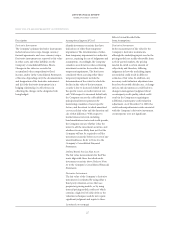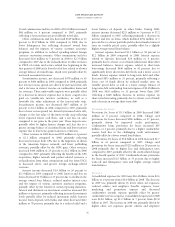American Express 2009 Annual Report Download - page 32
Download and view the complete annual report
Please find page 32 of the 2009 American Express annual report below. You can navigate through the pages in the report by either clicking on the pages listed below, or by using the keyword search tool below to find specific information within the annual report.
2009 FINANCIAL REVIEW
AMERICAN EXPRESS COMPANY
INCOME TAXES
Description Assumptions/Approach Used
Effect if Actual Results Differ
from Assumptions
The Company is subject to the income tax laws
of the United States, its states and
municipalities and those of the foreign
jurisdictions in which the Company operates.
These tax laws are complex, and the manner in
which they apply to the taxpayer’s facts is
sometimes open to interpretation. In
establishing a provision for income tax expense,
the Company must make judgments about the
application of these inherently complex tax
laws.
Unrecognized Tax Benefits
The Company establishes a liability for
unrecognized tax benefits, which are the
differences between a tax position taken or
expected to be taken in a tax return and the
benefit recognized in the financial statements.
Deferred Taxes
Deferred tax assets and liabilities are
determined based on the differences between
the financial statement and tax bases of assets
and liabilities using the enacted tax rates
expected to be in effect for the years in which
the differences are expected to reverse. A
valuation allowance is established when
management determines that it is more likely
than not that all or some portion of the benefit
of the deferred tax asset will not be realized.
Unrecognized Tax Benefits
In establishing a liability for an
unrecognized tax benefit, assumptions may
be made in determining whether a tax
position is more likely than not to be
sustained upon examination by the taxing
authority and also in determining the
ultimate amount that is likely to be realized.
A tax position is recognized only when,
based on management’s judgment regarding
the application of income tax laws, it is
more likely than not that the tax position
will be sustained upon examination. The
amount of tax benefit recognized is based on
the Company’s assessment of the most likely
outcome on ultimate settlement with the
taxing authority. This measurement is based
on many factors, including whether a tax
dispute may be settled through negotiation
with the taxing authority or is only subject
to review in the courts. As new information
becomes available, the Company evaluates
its tax positions, and adjusts its
unrecognized tax benefits, as appropriate.
Deferred Taxes
Since deferred taxes measure the future tax
effects of items recognized in the financial
statements, certain estimates and
assumptions are required to determine
whether it is more likely than not that all or
some portion of the benefit of a deferred tax
asset will not be realized. In making this
assessment, management analyzes and
estimates the impact of future taxable
income, reversing temporary differences and
available tax planning strategies. These
assessments are performed quarterly, taking
into account any new information.
Unrecognized Tax Benefits
If the tax benefit ultimately realized
differs from the amount previously
recognized in the income tax provision,
the Company recognizes an adjustment
of the unrecognized tax benefit through
the income tax provision.
Deferred Taxes
Should a change in facts or
circumstances lead to a change in
judgment about the ultimate realizability
of a deferred tax asset, the Company
records or adjusts the related valuation
allowance in the period that the change
in facts or circumstances occurs, along
with a corresponding increase or
decrease to the income tax provision.
30
























